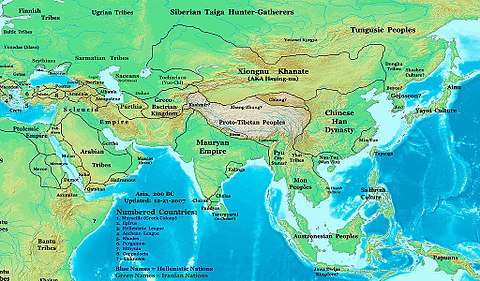Sa Huỳnh culture
| Part of a series on |
| Prehistoric and ancient cultures of Vietnam |
|---|
| Paleolithic |
| Sơn Vi culture (20,000–12,000 BC) |
| Mesolithic |
| Hoabinhian (12,000–10,000 BC) |
| Neolithic |
|
| Bronze Age |
|
| Iron Age |
|

The Sa Huỳnh culture or Sa Huyun was a culture in modern-day central and southern Vietnam that flourished between 1000 BC and 200 AD.[1][2] Archaeological sites from the culture have been discovered from the Mekong Delta to Quang Binh province in central Vietnam. The Sa Huynh people were most likely the predecessors of the Cham people, an Austronesian-speaking people and the founders of the kingdom of Champa.[3]:211–217
The site at Sa Huynh was discovered in 1909. Sa Huynh sites were rich in locally worked iron artefacts, typified by axes, swords, spearheads, knives and sickles. In contrast, bronze artifacts were dominant in the Đông Sơn culture sites found in northern Vietnam and elsewhere in mainland Southeast Asia.
The Sa Huynh culture cremated adults and buried them in jars covered with lids, a practice unique to the culture. Ritually broken offerings usually accompanied the jar burials. The culture is also typified by its unique ear ornaments featuring two-headed animals, believed by some to depict saola.[4]. The ornaments were commonly made from jade (nephrite), but also made from glass. Bead ornaments were also commonly found in Sa Huynh burials, most commonly made from glass.
The Sa Huynh culture showed evidence of an extensive trade network. Sa Huynh beads were made from glass, carnelian, agate, olivine, zircon, gold and garnet; most of these materials were not local to the region, and were most likely imported. Han Dynasty-style bronze mirrors were also found in Sa Huynh sites. Conversely, Sa Huynh produced ear ornaments have been found in archaeological sites in Central Thailand, Taiwan (Orchid Island), and in the Philippines, in the Palawan Tabon Caves. [5][6]
Timeline of Iron age

- Dates are approximate, consult particular article for details
- Prehistoric (or Proto-historic) Iron Age Historic Iron Age
Artifacts
- Bronze weapon
- Pottery vase
- Pottery fruit tray
- Pottery burial jar
See also
References
- ↑ John N. Miksic, Geok Yian Goh, Sue O Connor - Rethinking Cultural Resource Management in Southeast Asia 2011 Page 251 "This site dates from the fifth to first century BCE and it is one of the earliest sites of the Sa Huỳnh culture in Thu Bồn Valley (Reinecke et al. 2002, 153–216); 2) Lai Nghi is a prehistoric cemetery richly equipped with iron tools and weapons, ..."
- ↑ Vietnam National Museum of Fine Arts (Bảo tàng mỹ thuật Việt Nam) 2000 "Right from the early history - before and after the Christian era - over twenty centuries ago, there was a cultural exchange among three major Centres Z Đông Sơn culture in the North, Sa Huỳnh culture in Central and south-eastern Nam Bộ ..."
- ↑ Higham, C., 2014, Early Mainland Southeast Asia, Bangkok: River Books Co., Ltd., ISBN 9786167339443
- ↑ deBuys, William (2015). The Last Unicorn: A Search For One Of Earth's Rarest Creatures. p. 267.
- ↑ Solheim, William (1969). "Prehistoric Archaeology in Eastern Mainland Southeast Asia and the Philippines". Asian Perspectives. 3: 97–108. hdl:10125/19126.
- ↑ Miksic, John N. (2003). Earthenware in Southeast Asia: Proceedings of the Singapore Symposium on Premodern Southeast Asian Earthenwares. Singapore: Singapore University Press, National University of Singapore.
- Higham, Charles, The Bronze Age of Southeast Asia, ISBN 0-521-56505-7
- Higham, Charles, Early Cultures of Mainland Southeast Asia, ISBN 1-58886-028-0